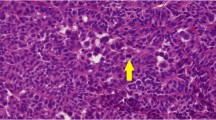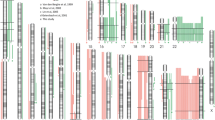Abstract
By allelotyping analysis, we previously reported a putative progression pathway from germ cell neoplasia in situ (GCNIS) to seminoma, then to embryonal carcinoma in mixed-type testicular germ cell tumors (TGCTs), and detected that loss of heterozygosity events in seminoma components in mixed tumors were more frequent than those in pure seminomas. To elucidate a role of chromosomal instability in the progression of non-seminomatous germ cell tumor (NSGCT), we performed fluorescence in situ hybridization with centromeric probes for chromosomes 1, 7, 8, 12, 17, and X on a cohort of 52 TGCT cases with 103 histologically distinct components: 39 GCNIS lesions (16 and 23 in tumors with and without NSGCT components, respectively), 39 seminomas (27 as pure seminomas and 12 in mixed tumors), and 25 embryonal carcinomas. On a total component basis, both the mean copy number per tumor cell nucleus and the deviations from the modal number of all chromosomes examined significantly increased from GCNIS to seminoma, then to embryonal carcinoma with few exceptions. Seminoma components in mixed tumors showed a significantly greater extent of chromosomal instability in chromosomes 8 and 12 than pure seminomas, whereas no statistically significant difference was observed between GCNIS lesions with and without NSGCT components. These results suggest that not only aneuploidy, but also the cell-to-cell variation of chromosomal number is a sensitive indicator of chromosomal instability and would be implicated in the progression of NSGCT.


Similar content being viewed by others
References
Mostofi FK, Sesterhenn IA (2016) Germ cell tumours. Tumours of the testis and paratesticular tissue. In: Mock H, Humphrey PA, Ulbright TM, Reuter VE (eds) WHO classification of tumours of the urinary system and male genital organs. IARC press, Lyon, pp 189–226
Jacobsen GK, Barlebo H, Olsen HJ, Schultz HP, Starklint H, Søgaard H, Vaeth M (1984) Testicular germ cell tumours in Denmark 1976–1980 pathology of 1058 consecutive cases. Acta Radiol Oncol 23:239–247
Bosl GJ, Motzer RJ (1997) Medical progress: testicular germ-cell cancer. N Engl J Med 337:242–253
Kollmannsberger C, Nichols C, Bokemeyer C (2006) Recent advances in management of patients with platinum-refractory testicular germ cell tumors. Cancer 106:1217–1226 https://doi.org/10.1002/cncr.21742
Skakkebaek NE, Berthelsen JG, Giwercman A, Müller J (1987) Carcinoma-in-situ of the testis: possible origin from gonocytes and precursor of all types of germ cell tumours except spermatocytoma. Int J Androl 10:19–28
Berney DM, Looijenga LH, Idrees M, Oosterhuis JW, Rajpert-De Meyts E, Ulbright TM, Skakkebaek NE (2016) Germ cell neoplasia in situ (GCNIS): evolution of the current nomenclature for testicular pre-invasive germ cell malignancy. Histopathology 69:7–10. https://doi.org/10.1111/his.12958
Oosterhuis JW, Looijenga LH (1993) The biology of human germ cell tumours: retrospective speculations and new prospectives. Eur Urol 23:245–250
Sperger JM, Chen X, Draper JS, Antosiewicz JE, Chon CH, Jones SB, Brooks JD, Andrews PW, Brown PO, Thomson JA (2003) Gene expression patterns in human embryonic stem cells and human pluripotent germ cell tumors. Proc Natl Acad Sci U S A 100:13350–13355. https://doi.org/10.1073/pnas.2235735100
Miyai K, Yamamoto S, Iwaya K, Asano T, Tamai S, Tsuda H, Matsubara O (2013) Allelotyping analysis suggesting a consecutive progression from intratubular germ cell neoplasia to seminoma and then to embryonal carcinoma of the adult testis. Hum Pathol 44:2312–2322. https://doi.org/10.1016/j.humpath.2013.05.013
Miyai K, Ito K, Nakanishi K, Tsuda H (2018) Seminoma component of mixed testicular germ cell tumor shows a higher incidence of loss of heterozygosity than pure-type seminoma. Hum Pathol 84:71–80. https://doi.org/10.1016/j.humpath.2018.09.007
van Echten J, Oosterhuis JW, Looijenga LH, van de Pol M, Wiersema J, te Meerman GJ, Schaffordt Koops H, Sleijfer DT, de Jong B (1995) No recurrent structural abnormalities apart from i(12p) in primary germ cell tumors of the adult testis. Genes Chromosomes Cancer 14:133–144
Korn WM, Oide Weghuis DE, Suijkerbuijk RF, Schmidt U, Otto T, du Manoir S, Geurts van Kessel A, Harstrick A, Seeber S, Becher R (1996) Detection of chromosomal DNA gains and losses in testicular germ cell tumors by comparative genomic hybridization. Genes Chromosomes Cancer 17:78–87. https://doi.org/10.1002/(SICI)1098-2264(199610)17:2<78::AID-GCC2>3.0.CO;2-Y
Mostert MM, van de Pol M, Olde Weghuis D, Suijkerbuijk RF, Geurts van Kessel A, van Echten J, Oosterhuis JW, Looijenga LH (1996) Comparative genomic hybridization of germ cell tumors of the adult testis: confirmation of karyotypic findings and identification of a 12p-amplicon. Cancer Genet Cytogenet 89:146–152
Sandberg AA, Meloni AM, Suijkerbuijk RF (1996) Reviews of chromosome studies in urological tumors. III Cytogenetics and genes in testicular tumors. J Urol 155:1531–1556
Summersgill BM, Jafer O, Wang R, Goker H, Niculescu-Duvaz I, Huddart R, Shipley J (2001) Definition of chromosome aberrations in testicular germ cell tumor cell lines by 24-color karyotyping and complementary molecular cytogenetic analyses. Cancer Genet Cytogenet 128:120–129
Kraggerud SM, Skotheim RI, Szymanska J, Eknaes M, Fosså SD, Stenwig AE, Peltomäki P, Lothe RA (2002) Genome profiles of familial/bilateral and sporadic testicular germ cell tumors. Genes Chromosomes Cancer 34:168–174. https://doi.org/10.1002/gcc.10058
Brimo F, Srigley JR, Ryan CJ, Choyke PL, Humphrey PA, Barocas DA, Brookland RK, Buyyounouski MK, Fine SW, Halabi S, Hamstra DA, Kattan MW, McKenney JK, Mason MD, Oh WK, Pettaway CA, Touijer KA, Zelefsky MJ, Sandler HM, Amin MB, Lin DW (2017) Testis. In: Amin MB, Edge S, Greene F et al (eds) AJCC cancer staging manual, 8th edn. Springer International publishing, New York, pp 727–735
Tsuda H, Akiyama F, Terasaki H, Hasegawa T, Kurosumi M, Shimadzu M, Yamamori S, Sakamoto G (2001) Detection of HER-2/neu (c-erb B-2) DNA amplification in primary breast carcinoma. Interobserver reproducibility and correlation with immunohistochemical HER-2 overexpression. Cancer 92:2965–2974
Lengauer C, Kinzler KW, Vogelstein B (1997) Genetic instability in colorectal cancers. Nature 386:623–627
Minhas KM, Singh B, Jiang WW, Sidransky D, Califano JA (2003) Spindle assembly checkpoint defects and chromosomal instability in head and neck squamous cell carcinoma. Int J Cancer 107:46–52. https://doi.org/10.1002/ijc.11341
Stebbins GL (1947) Types of polyploids: their classification and significance. Adv Genet 1:403–429
Otto SP, Whitton J (2000) Polyploid incidence and evolution. Annu Rev Genet 34:401–437. https://doi.org/10.1146/annurev.genet.34.1.401
Paulson TG, Maley CC, Li X, Li H, Sanchez CA, Chao DL, Odze RD, Vaughan TL, Blount PL, Reid BJ (2009) Chromosomal instability and copy number alterations in Barrett’s esophagus and esophageal adenocarcinoma. Clin Cancer Res 15:3305–3314. https://doi.org/10.1158/1078-0432.CCR-08-2494
Carlson JA, Healy K, Tran TA, Malfetano J, Wilson VL, Rohwedder A, Ross JS (2000) Chromosome 17 aneusomy detected by fluorescence in situ hybridization in vulvar squamous cell carcinomas and synchronous vulvar skin. Am J Pathol 157:973–983. https://doi.org/10.1016/S0002-9440(10)64610-X
de Graaff WE, Oosterhuis JW, de Jong B, Dam A, van Putten WL, Castedo SM, Sleijfer DT, Schraffordt Koops H (1992) Ploidy of testicular carcinoma in situ. Lab Investig 66:166–168
Kaprova-Pleskacova J, Stoop H, Brüggenwirth H, Cools M, Wolffenbuttel KP, Drop SL, Snajderova M, Lebl J, Oosterhuis JW, Looijenga LH (2014) Complete androgen insensitivity syndrome: factors influencing gonadal histology including germ cell pathology. Mod Pathol 27:721–730. https://doi.org/10.1038/modpathol.2013.193
Looijenga LH, Gillis AJ, Van Putten WL, Oosterhuis JW (1993) In situ numeric analysis of centromeric regions of chromosomes 1, 12, and 15 of seminomas, nonseminomatous germ cell tumors, and carcinoma in situ of human testis. Lab Investig 68:211–219
Gainetdinov IV, Kondratieva SA, Skvortsova YV, Zinovyeva MV, Stukacheva EA, Klimov A, Tryakin AA, Azhikina TL (2016) Distinguishing epigenetic features of preneoplastic testis tissues adjacent to seminomas and nonseminomas. Oncotarget 7:22439–22447. https://doi.org/10.18632/oncotarget.7074
Yegnasubramanian S, Haffner MC, Zhang Y, Gurel B, Cornish TC, Wu Z, Irizarry RA, Morgan J, Hicks J, DeWeese TL, Isaacs WB, Bova GS, De Marzo AM, Nelson WG (2008) DNA hypomethylation arises later in prostate cancer progression than CpG island hypermethylation and contributes to metastatic tumor heterogeneity. Cancer Res 68:8954–8967. https://doi.org/10.1158/0008-5472.CAN-07-6088
Baba Y, Huttenhower C, Nosho K, Tanaka N, Shima K, Hazra A, Schernhammer ES, Hunter DJ, Giovannucci EL, Fuchs CS, Ogino S (2010) Epigenomic diversity of colorectal cancer indicated by LINE-1 methylation in a database of 869 tumors. Mol Cancer 9:125. https://doi.org/10.1186/1476-4598-9-125
Igarashi S, Suzuki H, Niinuma T, Shimizu H, Nojima M, Iwaki H, Nobuoka T, Nishida T, Miyazaki Y, Takamaru H, Yamamoto E, Yamamoto H, Tokino T, Hasegawa T, Hirata K, Imai K, Toyota M, Shinomura Y (2010) A novel correlation between LINE-1 hypomethylation and the malignancy of gastrointestinal stromal tumors. Clin Cancer Res 16:5114–5123. https://doi.org/10.1158/1078-0432.CCR-10-0581
Hofer MD, Browne TJ, He L, Skotheim RI, Lothe RA, Rubin MA (2005) Identification of two molecular groups of seminomas by using expression and tissue microarrays. Clin Cancer Res 11:5722–5729. https://doi.org/10.1158/1078-0432.CCR-05-0533
Smiraglia DJ, Szymanska J, Kraggerud SM, Lothe RA, Peltomäki P, Plass C (2002) Distinct epigenetic phenotypes in seminomatous and nonseminomatous testicular germ cell tumors. Oncogene 21:3909–3916. https://doi.org/10.1038/sj.onc.1205488
Netto GJ, Nakai Y, Makayama M, Jadallah S, Toubaji A, Nonomura N, Albadine R, Hicks JL, Epstein JI, Yegnasubramanian S, Nelson WG, De Marzo AM (2008) Global DNA hypomethylation in intratubular germ cell neoplasia and seminoma, but not in nonseminomatous male germ cell tumors. Mod Pathol 21:1337–1344. https://doi.org/10.1038/modpathol.2008.127
Pedersen LH, Nielsen JE, Daugaard G, Hansen TV, Rajpert-De Meyts E, Almstrup K (2016) Differences in global DNA methylation of testicular seminoma are not associated with changes in histone modifications, clinical prognosis, BRAF mutations or gene expression. Cancer Genet 209:506–514. https://doi.org/10.1016/j.cancergen.2016.10.003
Funding
This work was supported in part by a grant-in-aid for the Promotion of Defense Medicine from the Ministry of Defense, Japan (K.M., H.T.).
Author information
Authors and Affiliations
Contributions
K.M. collected the clinical patient data, examined histopathological findings, performed the experiments (FISH), evaluated the FISH data, analyzed the data, participated in the study design, and wrote the manuscript. K.I. assisted in clinical data acquisition, histopathological examination, and revised the manuscript. K.N. stimulated the study, provided the reference pathology for all the samples used, and revised the manuscript. H.T. conceived the study, analyzed the data, and drafted and revised the manuscript.
Corresponding author
Ethics declarations
All patients gave informed consent for retention and anonymous analysis of their tissue for research purposes in accordance with the requirements of the ethical committee of the National Defense Medical College (Approval No. 168).
Conflict of interest
The authors declare that there is no conflict of interest.
Additional information
Publisher’s note
Springer Nature remains neutral with regard to jurisdictional claims in published maps and institutional affiliations.
Rights and permissions
About this article
Cite this article
Miyai, K., Ito, K., Nakanishi, K. et al. Cell-to-cell variation of chromosomal number in the adult testicular germ cell tumors: a comparison of chromosomal instability among histological components and its putative role in tumor progression. Virchows Arch 474, 711–720 (2019). https://doi.org/10.1007/s00428-019-02560-6
Received:
Revised:
Accepted:
Published:
Issue Date:
DOI: https://doi.org/10.1007/s00428-019-02560-6




